Looking back at the decentralized storage track that has been neglected by the market from EthStorage
Reflecting on the overlooked decentralized storage market, as seen in EthStorage.Author: Alfred, LD Capital
One of the hottest tracks this year should be the L2 track that enhances blockchain scalability. After successful implementation, faster speed and lower fees will promote the gradual prosperity of Web3 applications, and the generation of a large amount of data in the future will demand explosive storage. This article will focus on EthStorage, the first place winner in this year’s EDCON Super Demo, to review the decentralized storage track, which has low market heat but huge potential.
1. Development Process of Network Storage
Consensus, computation, and storage are the three pillars and underlying infrastructure of Web3. Data and information generation require storage. Storage technology has been exploring and breaking through since the birth of computers, and this article divides it into four stages.
- What does Bitcoin being in an extreme oversold state mean?
- What impact would it have if the US SEC approves Ethereum futures ETF?
- In-depth analysis of how the MEV market transitions from ‘zero-sum game’ to ‘separation of powers
1. Centralized Storage: Centralized storage + centralized management
Computers initially started using paper tapes to record data, and later IBM manufactured the first hard disk as a storage medium in 1956, entering the familiar computer storage method we have today.
The devices for centralized storage have been iterating, such as hard disks, magnetic tapes, storage cards, SSDs, etc., but the storage architecture is fixed. Terminal devices can access and request data from storage resources through the network, but all data storage resources are centralized in one central location or server, under unified control and management.
2. Cloud Storage: Distributed storage + centralized management
In 2006, Amazon AWS went online and launched EC2 and S3 cloud storage services, marking the beginning of a new era for storage. Microsoft, Google, Alibaba, and others have followed suit, making it the most widely used storage method today.
Cloud storage adopts a distributed storage architecture, using multiple servers to store data in a dispersed manner, dividing the data into multiple server backups, reducing single point failures, and having features such as reducing data redundancy and elastic expansion. However, the servers of cloud storage are centrally managed by cloud service providers, and the actual control of the data does not belong to the users.
3. Traditional Blockchain Storage: Distributed, full-node storage + decentralized management
Since the birth of Bitcoin, blockchain network storage has become an alternative solution to centralized storage and management. Through distributed storage, consensus mechanisms, and transaction verification mechanisms, blockchain ensures data security and immutability, while meeting the characteristics of decentralized storage and decentralized management.
However, the storage costs of blockchain networks such as Bitcoin and Ethereum are high, and the efficiency is low. This is mainly because the network architecture of these blockchains is not designed from the perspective of storage. Each node needs to store a copy of the data, and the block space is limited. Taking Bored Ape Yacht Club NFT as an example, storing one piece on the Bitcoin or Ethereum network requires at least hundreds of dollars.
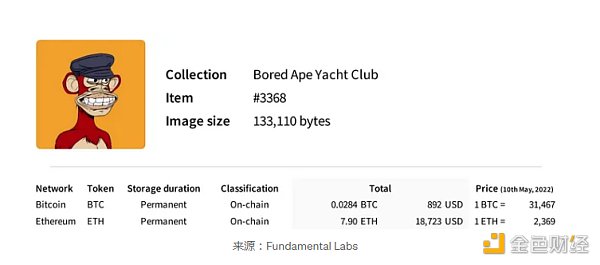
4. Web3 Decentralized Storage: Distributed, multi-node storage + decentralized management
Because storing data directly on the blockchain is very expensive, many decentralized storage solutions and projects have emerged in the web3 space, such as IFPS, Filecoin, Storj, Arweave, Swarm, EthStorage, etc. The goal of these projects is to increase storage space and reduce costs while maintaining decentralized storage and management, using technologies such as data fragmentation, multi-node storage, on-chain proofs, etc.
II. ETH Modularity and World Computer
1. ETH Modularity
Since the introduction of the Rollup-centered roadmap in 2021, the modularity of Ethereum has begun to take shape. The single all-in-one chain (*monolithic blockchain) is being split into different layers, with different modules or chains responsible for different functions, enabling scalability. Vitalik has referred to this direction as the “Endgame”.
Ethereum, as a representative of blockchain, splits the chain into four key layers:
(1) Execution Layer: transaction processing, smart contract execution, computation, etc.
(2) Settlement Layer: verification of execution results, dispute resolution, and settlement state commitments.
(3) Consensus Layer: deciding the order and validity of transactions, and achieving consensus among nodes.
(4) Data Availability Layer: ensuring data can be used, stored, and verified.
In a monolithic blockchain, the blockchain handles all four functions and faces the “trilemma” of blockchain. Modularizing the blockchain can split the four functions into multiple specialized layers to solve different problems.
After the modularity of ETH, the ETH main chain becomes L1, and many L2 solutions have emerged on top of it, mainly serving as the execution layer of ETH. For example, the L2 technology of OP Stack has also developed a modular architecture to enhance future scalability. ETH, through modularity and Rollup, will mainly focus on the data availability layer (DA) and the consensus layer in the future, becoming the mainstream and most secure base layer. The functions of other layers will be upgraded through other chains and solutions to achieve scalability and improve scalability of the entire ETH ecosystem.
2. World Computer
The goal of Ethereum is to build a world supercomputer. Currently, Ethereum has achieved good security, but it is still making breakthroughs in scalability. Rollup is an important direction for solving scalability, and modularity can to some extent solve the trilemma of blockchain. However, to become a supercomputer, Ethereum also needs to face three challenges: consensus, computation, and storage. These three challenges are interrelated and mutually restrictive.
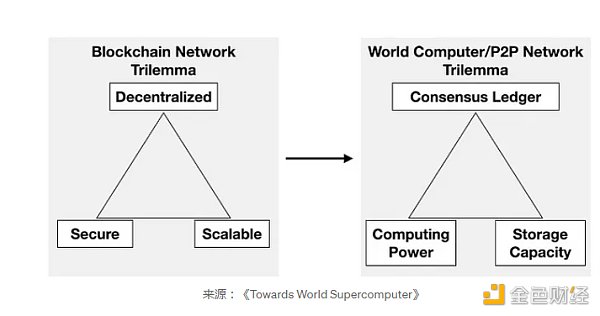
The different priorities of these three challenges will lead to different trade-offs:
Strong consensus ledger: inherently requires repetitive storage and computation, so it is not suitable for scalable storage and computation.
Strong computational power: requires reusing consensus when performing a large number of computation and proof tasks, so it is not suitable for large-scale storage.
Strong storage capability: It needs to reuse consensus when executing frequent random sampling space proofs, so it is not suitable for computation.
Currently, traditional L2 solutions also face the problem of centralized sequencers and balancing computational efficiency, and cannot provide strong storage capability. The authors of the article “Towards World Supercomputer” propose a bottom-up architecture based on partitioning the world’s computers by functionality to solve the trilemma of becoming a world computer.
The ultimate world supercomputer will be composed of three topologically heterogeneous P2P networks, similar to building physical computers, connecting consensus ledgers, computing networks, and storage networks through trustless buses (connectors) such as zero-knowledge proof technology, and assembling them into a world supercomputer. Other components can be added according to the needs of specific applications, and selecting and connecting each component appropriately will achieve a balance between consensus ledger, computing power, and storage capacity, ultimately ensuring the decentralization, high performance, and security of the world supercomputer. Among them, EthStorage serves as a solution for the storage module in the supercomputer architecture.
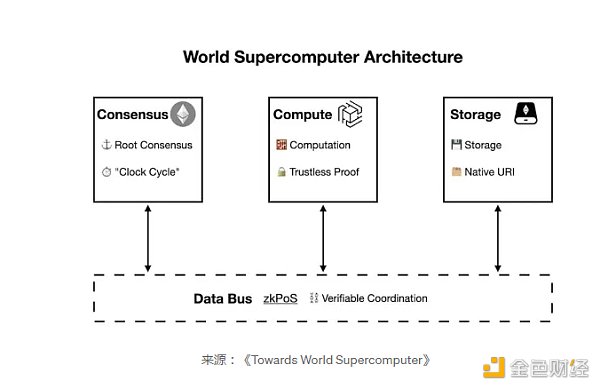
If based on this framework, the transaction process of Ethereum’s world supercomputer will be divided into the following steps:
(1) Consensus: Use Ethereum to process and achieve transaction consensus.
(2) Computation: The zkOracle network verifies proofs and consensus data transmitted by zkPoS as a bus, and performs relevant off-chain calculations.
(3) Consensus: In some cases, such as automation and machine learning, the computing network will use proofs to send data and transactions back to Ethereum or EthStorage.
(4) Storage: For storing large amounts of data from Ethereum (e.g., NFT metadata), zkPoS acts as a messenger between Ethereum smart contracts and EthStorage.
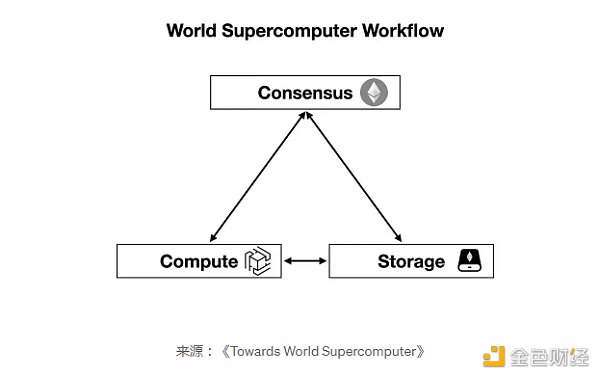
III. ETH Storage
1. Introduction
EthStorage is the first Layer 2 solution that provides programmable dynamic storage based on Ethereum’s data availability, which can extend programmable storage to hundreds of TB or even PB levels at a cost of 1/100 to 1/1000.
The team has twice received funding from the Ethereum Foundation to support the research work on data availability and the direction of L2 dynamic dataset storage proofs using Ethereum L1 contracts. They also won first place in the 2023 EDCON Super Demo.
2. Technical Features
(1) Highly integrated with ETH
The client of EthStorage is a superset of the Ethereum client Geth, which means that when running nodes of EthStorage, they can still participate in any process of Ethereum normally. A node can be both a validator node of Ethereum and a data node of EthStorage. The Data Provider module of each EthStorage node will initiate connection requests with other EthStorage nodes’ Data Providers. Once they are connected to each other, they actually form a decentralized storage network.
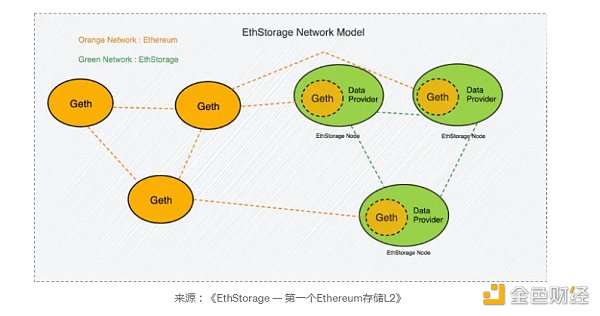
Users of EthStorage can directly use existing wallets to interact with all applications built on top of the storage, whether it’s NFTs, decentralized social networks, or decentralized games, to minimize the barrier for users to enter EthStorage. At the same time, EthStorage, which is compatible with EVM, can bring excellent interoperability to smart contracts. For example, if user A wants to set an image for the NFT they minted, with EthStorage, A only needs to execute one Ethereum transaction. When using Arweave, A needs to submit one Arweave transaction and two Ethereum transactions, and cannot achieve synchronous execution like EthStorage.
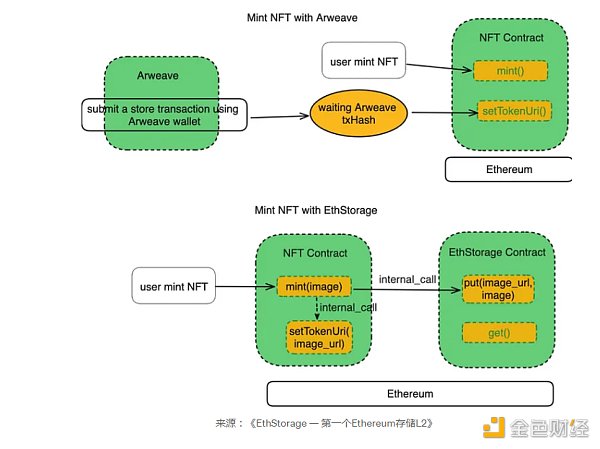
(2) L2-based decentralized solution based on DA layer
In fact, EthStorage adopts a architecture similar to L2. A storage contract will be deployed on Ethereum as the entry point for data operations of EthStorage, and the proofs of off-chain storage data will also need to be verified through this contract.
Comparison with current L2:
Rollup (L2) stores the state tree off-chain, and the commitment on-chain is the root of the state tree. After receiving new data, Rollup also needs to execute transactions off-chain to complete the process of state transition and establish a new state tree;
EthStorage stores the data off-chain, and the commitment on-chain is the proof of data storage. After receiving requests to update stored data, EthStorage will generate new storage proofs for these data.
It can be seen that the current direction of scalability for Optimism Rollup or ZK-Rollup is to scale Ethereum’s computing power, while EthStorage Rollup aims to scale Ethereum’s data storage capacity.
At the same time, EthStorage is a modular storage layer that can run on any blockchain as long as there is EVM and DA to reduce storage costs (*but many Layer1 currently do not have a DA layer), even on Layer2. For example, EthStorage is currently considering how to use its technology to implement fraud proofs on Optimism. The corresponding DA layer has also been enabled on Optimism.
(3) Achieving dynamic storage
From the perspective of system design and architecture, Filecoin and Arweave are more suitable for static storage, where a large amount of data can be uploaded to decentralized storage but cannot be modified or deleted, and only new data can be re-uploaded. Thanks to the key-value storage paradigm, EthStorage supports CRUD operations, which means creating new stored data, updating stored data, reading stored data, and deleting stored data. This is easy to achieve in centralized storage, but currently only EthStorage can do this in decentralized storage.
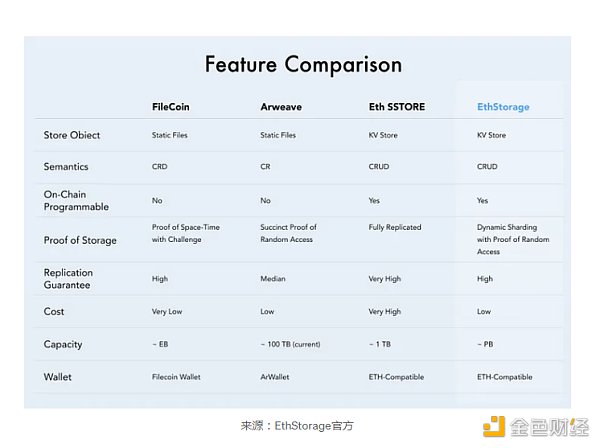
(4) Creating Ethereum Network Access Protocol
In the Web2 Internet, browsing web pages, sending emails, downloading files, and a series of other activities all rely on the HTTP protocol, which is one of the most common protocols on the Internet. The HTTP protocol defines how clients and servers transmit and exchange resources, and URLs are used to identify the locations of these resources on the Internet. When entering a URL in a web browser or clicking on a link, an HTTP request is triggered, which uses the URL to determine the requested resource. The web browser parses the URL, then communicates with the server using the HTTP protocol, requests the specific resource, and displays it to the user after receiving a response from the server. The HTTP protocol and URLs work closely together to form the foundation for browsing, interacting, and transmitting resources on the web. However, the data of Web2 web pages or Internet services is hosted on centralized servers. When the server’s subscription is not renewed, the cloud service used by the application will stop, and the application’s data will be deleted by the centralized service provider.
EthStorage founder proposed a web access protocol based on Web3 – ERC-4804, which was ultimately reviewed and approved through EIP. ERC-4804, full name Web3 URL for EVM Call Interpretation, is an HTTP-style Web3 URL (*web3://) for calling information from the EVM. It is the first network access protocol on Ethereum. Unlike web2, which accesses server resources, the web3:// access protocol directly renders resources hosted on Ethereum smart contracts, including HTML, CSS, PDF, and other files.
In simple terms, web3:// (*http://web3url.io) is a decentralized version of http://. It adds a decentralized presentation layer to Ethereum, allowing users to directly browse web content on the EVM, such as web pages, images, songs, etc., with the EVM serving as the decentralized backend.
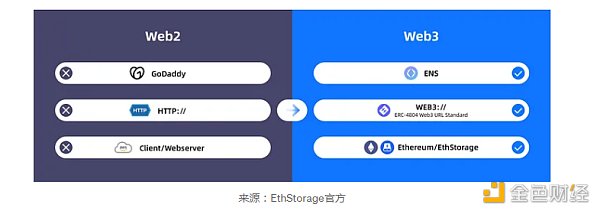
3. Current Status and Plans
(1) Product Applications
Through EthStorage, decentralized storage can be used as the underlying layer to re-enable Internet applications (many current Dapps still use centralized storage methods), such as dynamic NFTs, on-chain music NFTs, personal websites, hostless wallets, Dapps, Deweb, etc.
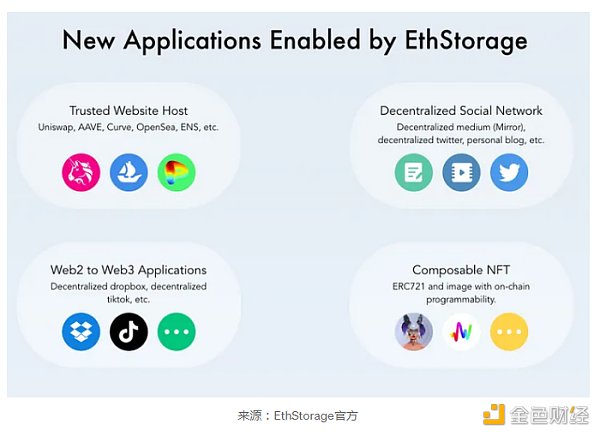
Take DeWeb as an example:
We know that Ethereum is a decentralized network, and many decentralized dapps have emerged on Ethereum. However, these dapps are not completely decentralized, as many of their front-ends are hosted on centralized cloud services. For example, when the front-end webpage of Uniswap goes down or when trading pairs are deleted, and when Tornado.Cash’s front-end services are suspended due to suspected money laundering, it is because their front-ends are hosted on centralized servers, making it difficult to resist censorship. However, with the use of EthStorage, web files and data are hosted in smart contracts and operated and maintained by a decentralized network, greatly enhancing censorship resistance. By leveraging the programmability of smart contracts, DeWeb can be implemented, enabling interesting applications such as De-github, De-blog, and various dapp front-ends.
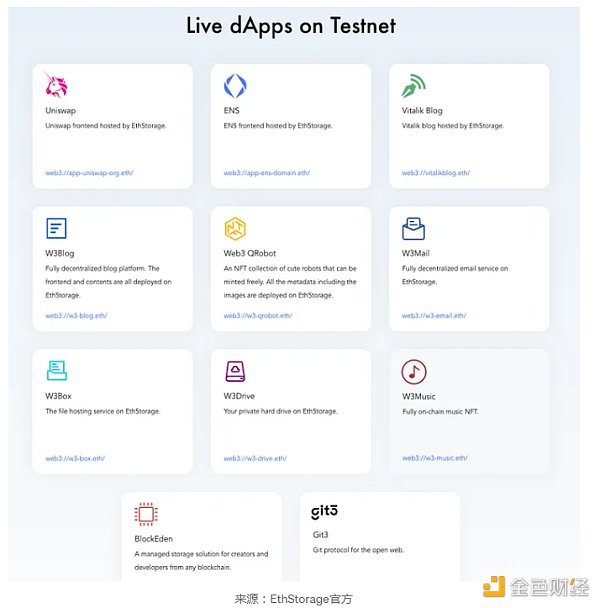
Currently, EthStorage has not announced a token plan, but in the test network, testing tokens W3Q can be used for testing and interaction.
(2) Roadmap
According to the roadmap published by EDCON, in 2023, EthStorage will mainly be in the test network stage and will adapt to the development and testing of the Ethereum Cancun upgrade. In 2024, the mainnet may be launched, fully integrating Danksharding, CL+EL clients, and Web3 browser access.
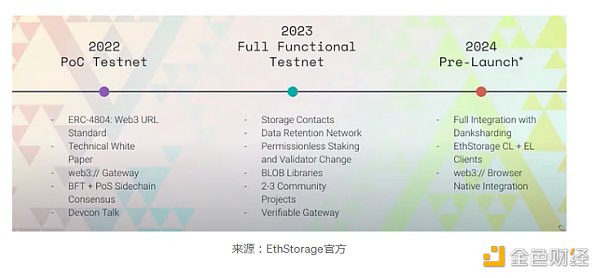
IV. Overview of Other Storage Projects
(1) Filecoin: Filecoin is a decentralized storage network built on top of IPFS. IPFS is a protocol (*similar to http) that uses a distributed hash table (DHT) for storing, addressing, and transmitting data. Filecoin acts as the incentive layer for IPFS and also serves as an open storage market. Filecoin uses a contract-based model to ensure data persistence and combines zero-knowledge proofs, especially space-time proofs and replication proofs. On March 14th of this year, Filecoin announced the official launch of the Filecoin Virtual Machine (FVM) to support smart contracts and user programmability.
The characteristics of Filecoin are: it has a separate chain and incentive system; large static storage space and low cost; supports FVM virtual machine after upgrade.
(2) Arweave: Arweave adopts the model of “one-time payment, permanent storage”, where a one-time payment covers the cost of permanently storing data, and retrieving the data does not require additional payment. Arweave uses concise proofs of random access to create the native data structure of the Blockweave, where each block is linked to a previous block and a history Recall Block. For nodes, the prerequisite for forging a new block is to synchronize a Recall Block and the latest generated block data.
The characteristics of Arweave are: it has a separate chain and incentive system; on-chain storage, permanent storage; weak interoperability with other chains.
(3) BNB Greenfield: Greenfield focuses on promoting decentralized data management and access, aiming to simplify data storage and management and link data ownership with the DeFi environment of BNB Smart Chain (BSC). The complete BNB Greenfield system can interact with the mature BSC public chain and the BN community users. When users want to create and use data on Greenfield, they can interact with BNB Greenfield dApps (decentralized applications) and the core infrastructure of BNB Greenfield.
The characteristics of BNB Greenfield are: the final piece of the Binance “triad” ecosystem network, strong operability within the ecosystem, BNB circulation and usage across chains; adopts the concept of Amazon S3 “storage bucket”; off-chain storage, on-chain verification.
5. Conclusion
Storage is one of the three pillars of the Web3 network. Decentralized storage can only truly achieve data ownership and sovereign networks when it is implemented. Otherwise, the significance of developing blockchain networks at the expense of centralized efficiency is limited. This track belongs to the underlying foundation, with great potential and significance.
Currently, compared to other tracks, decentralized storage has lower market popularity, mainly due to the stage of development not yet reached and insufficient demand. When the development of L2 makes Dapp applications cheap and fast, the accumulation of large amounts of data and value demands will push the market popularity towards the decentralized storage track.
As an emerging project, EthStorage has a good ecological foundation in Ethereum and strong interoperability. It can combine with other L1 and L2 projects with DA layer, providing new development directions and solutions. Currently, each decentralized storage project also has its own focus and continues to develop, looking forward to the era when the market gears towards the storage track.
References
1. EthStorage official website
2. “Towards World Supercomputer”, Xiaohang Yu, Kartin, msfew – Hyper Oracle, Qi Zhou – ETHStorage
3. “EthStorage – The First Ethereum Storage L2”, 0xhhh, 0xCryptolee
4. “Decentralized Storage: A Pillar of Web3”, Fundamental Labs
5. “Modular Blockchain: The Engineering Solution for Ethereum to Become the ‘World Computer'”, IOBC Capital
6. “EthStorage: Storage Performance for Scaling the Ethereum Ecosystem,” Mint Ventures
We will continue to update Blocking; if you have any questions or suggestions, please contact us!
Was this article helpful?
93 out of 132 found this helpful
Related articles
- Ethereum Futures ETF may be approved what will happen to the price?
- Reviewing the impact of US bond yields on the cryptocurrency market over the past two years a similar autumn market may very likely occur, just like the spring market this year.
- Survival Skills in the Cryptocurrency Dark Forest Wallet Security Strategies and Risk Hierarchy Management
- The truth hidden in 6,599 blockchain case judgments the verdicts are a mystery, and the execution is even more challenging.
- Why is Bitcoin falling? Analysts point out 5 potential reasons
- Web3 Social (1) Profit is the Essence of Socialization, Financialization of Social Interaction
- Former SEC Official Can a Spot Bitcoin ETF Be Approved? What Benefits Will Cryptocurrencies Have If the Republican Party Wins in 2024





